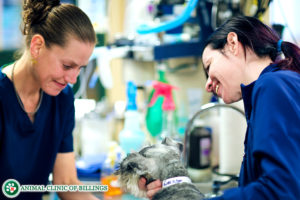Femoral Head and Neck Ostectomy (FHO) Surgery
What is a Femoral Head and Neck Ostectomy?
A Femoral Head and Neck Ostectomy is a surgery in which the head and neck of the femur are removed. The head of the femur (thigh bone) form the “ball” of the ball-and-socket hip joint. The neck of the femur is a short column of bone that attaches the head of the femur to the main body of the femur. Following removal of this bone segment, the body forms a fibrous false joint between the site of neck excision on the femur and the hip socket (acetabulum) of the pelvis. By eliminating contact between a diseased femoral head and/or acetabulum, this procedure is effective in restoring comfort while maintaining limb function.
When is this surgery indicated?
Femoral Head and Neck Ostectomy is often the treatment of choice for diseases of the hip, including hip dysplasia, Legg-Calve-Perthes Disease, slipped capital femoral physis, as well as traumatic hip injuries, including hip dislocation and fractures of the head and neck of the femur.
What kind of post-operative care is required with this surgery?
Unlike many other orthopedic surgeries, an early return to limb use is important to the recovery of normal limb function following an FHO. Range of motion exercises and stretches are started the day after surgery, and weight-bearing exercises such as slow walking and stepping over poles are added within another day or two. Many of these exercises can be performed at home, and must be continued until the tissues surrounding the false hip joint have fully healed. Weekly sessions with a physical rehabilitation therapy technician will allow for adjustment of a patient’s exercise routine as healing progresses. Typically, a patient will be back to full activity within four to eight weeks following surgery.
What is the prognosis following this surgery?
The long-term outcome following FHO surgery depends in part on the underlying problem. In the absence of any other injuries or abnormalities to the surgery limb or the other hind limb, the outcome is usually excellent, with full return to normal or near-normal function within two months. Sometimes, particularly in larger dogs, a slight asymmetry in gait may persist long-term as a result of the treated limb being a tiny bit shorter than the other hind limb, but this is not typically associated with any discomfort.
What are the possible complications of this surgery?
The main complication observed with this procedure is a loss of range of motion of the hip joint. This is avoidable with the early initiation of an appropriate physical rehabilitation therapy program.

Let our highly trained and experienced team of veterinarians and veterinary technicians help you keep your pet as happy and healthy as they can be.
Call the Animal Clinic of Billings and Animal Surgery Clinic to schedule your pet’s next wellness examination with one of our veterinarians today!
406-252-9499 REQUEST AN APPOINTMENT



